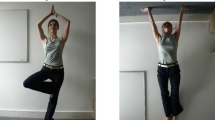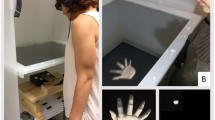Abstract
The observation of someone else’s action facilitates similar actions in the observer. Such priming effects can be driven by alignment between the observer and the observed in body-centred or spatial coordinates (or both). The separate and joint contributions of these sources of priming remain to be fully characterised. Here, we compare spatial and body priming effects across the whole body “space”, by using hand and foot responses. This allows a clearer separation of body priming from spatial priming than available from previous studies. In addition, we demonstrate two further features of these action priming effects. First, there are general interference and facilitation effects when the layout of viewed displays matches the participant’s body (e.g. hand above the foot). These effects have not been considered in previous studies. Second, by taking these layout effects into account, we identify the facilitation and interference components of spatial and body priming effects. Both types of priming effect are observed, and facilitation and interference effects are only observed when both body and spatial frames of reference are working in the same direction. These findings show that in action perception, the behaviours of others are processed simultaneously in multiple frames of reference that have complex, interacting effects—both facilitating and interfering—on the motor system of the observer.








Similar content being viewed by others
Notes
This main effect was also found in the analysis of experimental trials (see above). A control experiment in which participants (n = 5) used their right hand for keyboard as well as foot pedal responses showed that this main effect (significantly faster hand responses) was not due to differential delays in how responses were recorded from the keyboard and the foot pedal
.
References
Bach P, Tipper SP (2007) Implicit action encoding influences personal-trait judgments. Cognition 102:151–178
Bach P, Peatfield NA, Tipper SP (2007) Focusing on body sites: the role of spatial attention in action perception. Exp Brain Res 178:509–517
Bertenthal BI, Longo MR, Kosobud A (2006) Imitative response tendencies following observation of intransitive actions. J Exp Psychol Hum 32:210–225
Botvinick MM, Braver TS, Barach DM, Carter CS, Cohen JD (2001) Conflict monitoring and cognitive control. Psychol Rev 108:624–652
Brainard DH (1997) The psychophysics toolbox. Spat Vis 10:433–436
Brass M, Bekkering H, Wohlschläger A, Prinz W (2000) Compatibility between observed and executed finger movements: comparing symbolic, spatial and imitative cues. Brain Cogn 44:124–143
Brass M, Bekkering H, Prinz W (2001) Movement observation affects movement execution in a simple response task. Acta Psychol 106:3–22
Catmur C, Heyes CM (2011) Time course analyses confirm the independence of imitative and spatial compatibility. J Exp Psychol Hum 37:409–421
Downing PE, Jiang Y, Shuman M, Kanwisher NG (2001) A cortical area selective for visual processing of the human body. Science 293:2470–2473
Gillmeister H, Catmur C, Liepelt R, Brass M, Heyes C (2008) Experience-based priming of body-parts: a study on action imitation. Brain Res 1217:157–170
Heyes CM (2011) Automatic imitation. Psychol Bull 137:463–483
Jacques C, Rossion B (2007) Early electrophysiological responses to multiple face orientations correlate with individual discrimination performance in humans. NeuroImage 36:863–876
Leighton J, Heyes CM (2010) Hand to mouth: automatic imitation across effector systems. J Exp Psychol Hum 36:1174–1183
Liu X, Banich MT, Jacobson BL, Tanabe JL (2004) Common and distinct neural substrates of attentional control in an integrated Simon and spatial Stroop task as assessed by event related fMRI. NeuroImage 22:1097–1106
MacLeod CM (1991) Half a century of research on the Stroop effect: an integrative review. Psychol Bull 109:163–203
Minnebusch DA, Suchan B, Daum I (2009) Losing your head: behavioral and electrophysiological effects of body inversion. J Cogn Neurosci 21:865–874
Oosterhof NN, Wiggett AJ, Diedrichsen J, Tipper SP, Downing PE (2010) Surface-based information mapping reveals crossmodal vision-action representations in human parietal and occipitotemporal cortex. J Neurophysiol 104:1077–1089
Peterson BS, Kane MJ, Alexander GM, Lacadie C, Skudlarski P, Leung H-C, May J, Gore JC (2002) An event-related functional MRI study comparing interference effects in the Simon and Stroop task. Cogn Brain Res 13:427–440
Press C, Bird G, Walsh E, Heyes CM (2008) Automatic imitation of intransitive actions. Brain Cogn 67:44–50
Puce A, Perrett D (2003) Electrophysiology and brain imaging of biological motion. Philos T Roy Soc B 358:435–445
Simon JR (1969) Reactions towards the source of a stimulus. J Exp Psychol 81:174–176
Stroop JR (1935) Studies of interference in serial verbal reactions. J Exp Psychol 18:643–662
Stürmer B, Aschersleben G, Prinz W (2000) Correspondence effects with manual gestures and postures: a study of imitation. J Exp Psychol Hum 26:1746–1759
Tucker M, Ellis R (1998) On the relationship between seen objects and components of potential actions. J Exp Psychol Hum 24:830–846
Wiggett AJ, Hudson M, Tipper SP, Downing PE (2011) Learning associations between action and perception: effects of incompatible training on body part and spatial priming. Brain Cogn 76:87–89
Acknowledgments
This study was supported by ESRC RES-062-23-0980 to PD and ST.
Author information
Authors and Affiliations
Corresponding author
Rights and permissions
About this article
Cite this article
Wiggett, A.J., Downing, P.E. & Tipper, S.P. Facilitation and interference in spatial and body reference frames. Exp Brain Res 225, 119–131 (2013). https://doi.org/10.1007/s00221-012-3353-8
Received:
Accepted:
Published:
Issue Date:
DOI: https://doi.org/10.1007/s00221-012-3353-8




